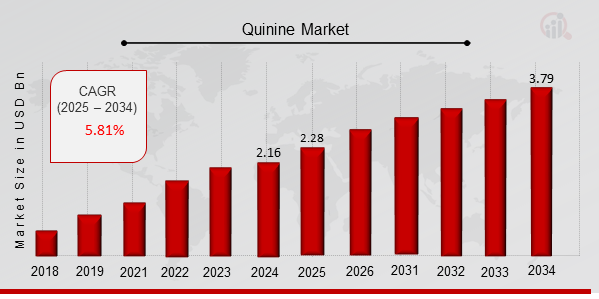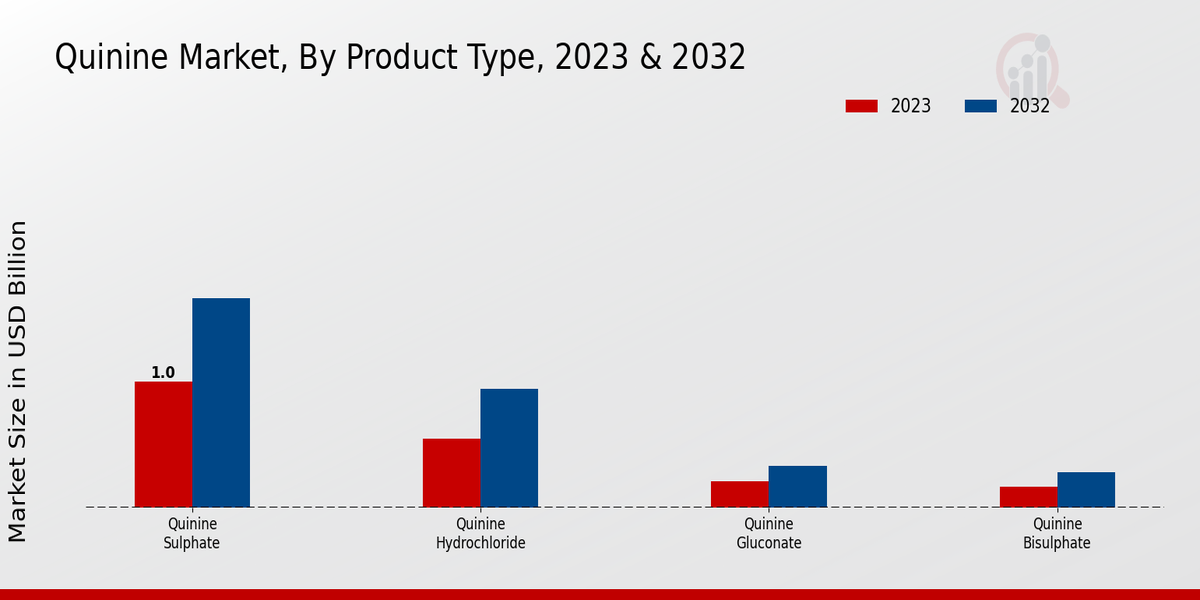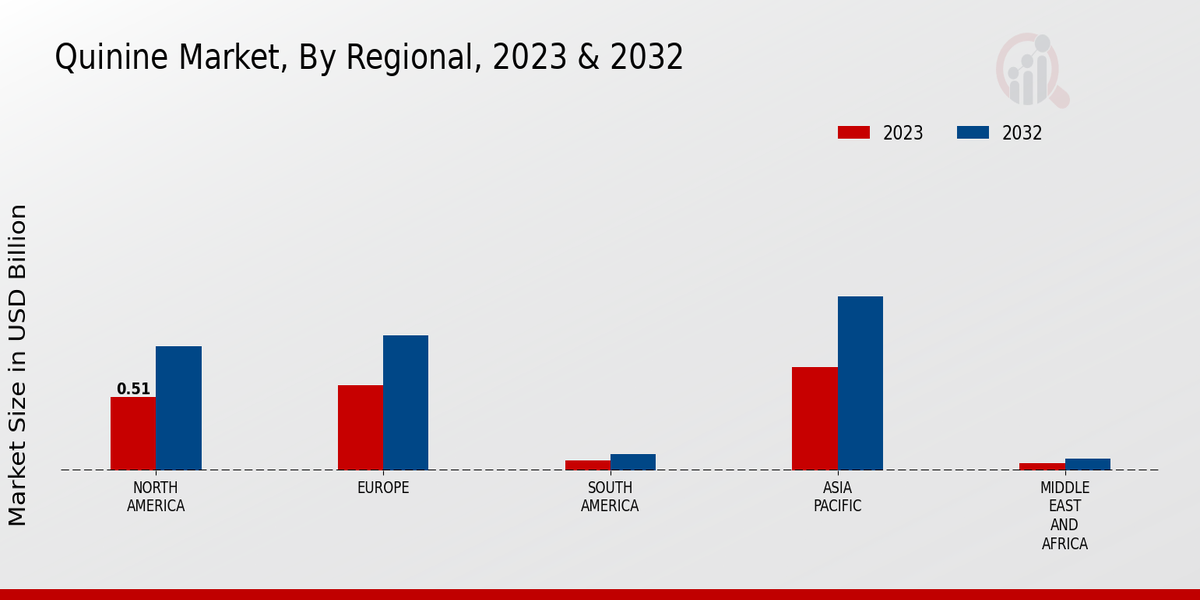Quinine Market Overview
As per MRFR analysis, the Quinine Market Size was estimated at 2.16 (USD Billion) in 2024. The Quinine Market Industry is expected to grow from 2.28 (USD Billion) in 2025 to 3.79 (USD Billion) till 2034, at a CAGR (growth rate) is expected to be around 5.81% during the forecast period (2025 - 2034).
Key Quinine Market Trends Highlighted
The resurgence of malaria, particularly in developing countries, is the primary driver of quinine demand. The effectiveness of quinine as a first-line treatment and its affordability in these regions contribute to its widespread use.
Additionally, the growing prevalence of drug-resistant malaria strains has led to an increased interest in quinine as an alternative therapy.
Expanding access to quinine in malaria-endemic regions presents a significant opportunity for market growth.
Governments and healthcare organizations are investing in programs to increase the availability and distribution of quinine, particularly in remote areas. Furthermore, the development of new formulations and delivery systems for quinine could enhance its efficacy and reach.
Advances in genetic engineering and synthetic chemistry have led to the creation of new quinine derivatives with improved properties.
These derivatives offer increased potency, reduced side effects, and enhanced solubility. Researchers are also exploring the use of quinine as a potential treatment for other conditions, such as rheumatoid arthritis and certain cancers.

Source: Primary Research, Secondary Research, MRFR Database and Analyst Review
Quinine Market Drivers
Rising Prevalence of Malaria and Other Infectious Diseases
The first major factor that contributes to the growth of the Quinine Market is the rising demand for antimalarial drugs. Malaria is one of the top public health concerns, especially in tropical and sub-tropical countries.
Indeed, in 2020, it is estimated that there was a total of 241 million malaria cases, leading to approximately 627,000 fatalities.
Quinine is among the principal antimalarial drugs that are generally used for the treatment of uncomplicated cases of this infectious disease, which is caused by the parasite Plasmodium falciparum.
The combined effect of the increased prevalence of malaria and the appearance of drug-resistant forms of the pathogen drives up the demand for this substance. Another reason for the expansion of the market is the rising incidence of infection with the plasmodium pathogen.
Lowering rates of awareness and the impact of the healthcare delivery system are specifically related to the growth of P. falciparum malaria incidences in relatively good hospital coverage zones.
Finally, the demand for this substance is enhanced by its use in the treatment of parasitic and infectious diseases other than malaria.
For instance, it is widely used for the treatment of babesiosis, a parasitic infection that is generally transmitted through tick bite, in addition to Pneumocystis jirovecii pneumonia, or PCP, which is an infectious disease that is frequent among individuals with a weakened immune system.
Growing Demand for Quinine in the Pharmaceutical Industry
Quinine is an essential ingredient in the production of various pharmaceutical formulations. It is used as an antipyretic (fever reducer) and an analgesic (pain reliever) in combination with other drugs.
Additionally, quinine is employed in the manufacture of tonic water, a carbonated beverage that contains a small amount of quinine. The growing pharmaceutical industry, particularly in emerging markets, is anticipated to drive the demand for quinine in the coming years.
Government Initiatives to Combat Malaria and Other Infectious Diseases
Governments worldwide have recognized the importance of combating malaria and other infectious diseases. They are implementing various initiatives and programs to control and eliminate these diseases.
These initiatives include providing access to affordable antimalarial treatments, strengthening healthcare infrastructure, and investing in research and development of new antimalarial drugs. Such government efforts are expected to positively impact the demand for quinine, as it remains a crucial component in the fight against malaria and other infectious diseases.
Quinine Market Segment Insights
Quinine Market Product Type Insights
Quinine market segmentation by product type includes Quinine Sulphate, Quinine Hydrochloride, Quinine Gluconate and Quinine Bisulphate. Quinine Sulphate is the most widely used product type, accounting for the largest revenue share in the Quinine Market.
The global Quinine Sulphate market is expected to witness significant growth over the forecast period due to its wide range of applications in the treatment of malaria, lupus, and other conditions.
Quinine Hydrochloride is another important product type with a significant market share. It is commonly used in the production of antimalarial drugs and other pharmaceutical formulations.
Quinine Gluconate and Quinine Bisulphate are used in various industries, including pharmaceuticals, food and beverage, and cosmetics. The demand for these products is expected to grow moderately during the forecast period. The increasing prevalence of malaria and other mosquito-borne diseases is driving the growth of the quinine market.
Quinine is an effective treatment for malaria, and it is also used to prevent and treat other conditions, such as lupus and leg cramps. The growing demand for quinine in the pharmaceutical industry is a major factor driving the growth of the quinine market.

Source: Primary Research, Secondary Research, MRFR Database and Analyst Review
Quinine Market Application Insights
Application segment is a vital part of Quinine Market segmentation. The Quinine Market – Malaria Treatment application is expected to witness considerable growth in the forecast period as the number of malaria cases is rising in several parts of the world.
According to the World Health Organization, there were an estimated 241 million cases of malaria in 2020 worldwide, as compared to 229 million in 2019.
Nocturnal Leg Cramps application is also expected to witness noteworthy growth in the forecast period, driven by the rising number of nocturnal leg cramps cases among the geriatric population.
In addition, the growing awareness about the use of Quinine for treating muscle pain and restless legs syndrome is expected to boost the market growth. The Quinine Market revenue for Muscle Pain application is anticipated to reach USD 366.2 million by 2028, registering a considerable CAGR during the forecast period.
The Quinine Market data states that the Restless Legs Syndrome application segment is expected to have a significant market share throughout the forecast period, as the prevalence of restless legs syndrome is increasing, and the geriatric population is also growing at a considerable rate.
Quinine Market Source Insights
The Quinine Market segmentation by Source segment comprises Cinchona Bark and Synthetic. Cinchona Bark is the traditional source of quinine, and it is extracted from the bark of the Cinchona tree. Synthetic Quinine is produced chemically and is a cost-effective alternative to Cinchona Bark.
The Quinine Market revenue from Synthetic Quinine is expected to grow at a faster rate than Cinchona Bark due to increasing demand from the pharmaceutical industry. In 2023, the Quinine Market size for Cinchona Bark was valued at 1.25 billion USD, while the Synthetic Quinine segment was valued at 0.68 billion USD.
The market growth for the Synthetic Quinine segment is driven by the increasing demand for cost-effective and readily available Quinine.
Quinine Market Distribution Channel Insights
The distribution channel segment plays a crucial role in the Quinine Market. Pharmacies account for a significant share of the market, driven by their wide reach and accessibility to patients.
Hospitals are another important distribution channel, particularly for specialized quinine formulations and in-patient treatments.
Online retailers have gained traction in recent years, offering convenience and a wider product selection. Wholesalers serve as intermediaries between manufacturers and other distribution channels, ensuring efficient supply chain management.
Quinine Market Regional Insights
The Quinine Market revenue is expected to grow significantly in the coming years. The market is segmented into various regions, including North America, Europe, APAC, South America, and MEA.
North America held the largest market share in 2023 and is expected to continue to dominate the market over the forecast period. Europe is expected to be the second largest market, followed by APAC.
The APAC region is expected to witness significant growth over the forecast period due to increasing demand from emerging economies such as China and India.
South America and MEA are expected to account for a smaller share of the global market. However, these regions are expected to witness steady growth over the forecast period.
The Quinine Market is highly competitive, with several major players operating in the market. Some of the key players include IPCA Laboratories Ltd., The Natrimax Group, and Jiangsu Aosaikang Pharmaceutical Co., Ltd.

Source: Primary Research, Secondary Research, MRFR Database and Analyst Review
Quinine Market Key Players and Competitive Insights:
Major players in the Quinine Market are constantly striving to gain a competitive edge by investing in research and development, expanding their product portfolios, and forming strategic partnerships. Leading Quinine Market players are focusing on developing innovative products that cater to the evolving needs of consumers.
The Quinine Market development is driven by factors such as rising demand for natural and herbal remedies, increasing awareness of the health benefits of quinine, and growing prevalence of malaria and other mosquito-borne diseases. The Quinine Market Competitive Landscape is expected to remain highly competitive in the coming years, with key players vying for market share through product differentiation, pricing strategies, and distribution channels.
A leading company in the Quinine Market is Sigma-Aldrich. The company offers a wide range of quinine products, including quinine sulfate, quinine dihydrochloride, and quinine bisulfate. Sigma-Aldrich has a strong global presence and a well-established distribution network. The company is committed to providing high-quality products and services to its customers.
A competitor company in the Quinine Market is Acros Organics. The company offers a range of quinine products, including quinine sulfate, quinine hydrochloride, and quinine base. Acros Organics has a strong presence in Europe and North America. The company is focused on providing high-quality products at competitive prices.
Key Companies in the Quinine Market Include
- RhonePoulenc Chimie
- DCI (India) Limited
- Delta Drug House Pvt. Ltd
- Copernicus Therapeutics
- Reddy's Laboratories
- Gujarat Alkaloids and Chemicals Limited
- Quinine Production Company
- Specifar
- Euro OTC Pharma GmbH
- Sanofi
- Malchem (India) Limited
- H. Chemicals Pharmaceuticals Private Limited
- Teva Pharmaceutical Industries Ltd.
- Meggle Pharma
Quinine Market Developments
The increasing prevalence of malaria and other mosquito-borne diseases is driving the demand for quinine, which is an effective antimalarial drug. Additionally, the rising demand for natural and herbal remedies is expected to further contribute to market growth.
Key market players are focusing on expanding their production capacities and investing in research and development to meet the growing demand. Recent developments include the launch of new quinine-based combination therapies and the approval of new manufacturing facilities in emerging markets.
Quinine Market Segmentation Insights
Quinine Market Product Type Outlook
- Quinine Sulphate
- Quinine Hydrochloride
- Quinine Gluconate
- Quinine Bisulphate
Quinine Market Application Outlook
- Malaria Treatment
- Nocturnal Leg Cramps
- Muscle Pain
- Restless Legs Syndrome
Quinine Market Source Outlook
Quinine Market Distribution Channel Outlook
- Pharmacies
- Hospitals
- Online Retailers
- Wholesalers
Quinine Market Regional Outlook
- North America
- Europe
- South America
- Asia-Pacific
- Middle East and Africa
| Report Attribute/Metric |
Details |
|
Market Size 2024
|
2.16 (USD Billion)
|
|
Market Size 2025
|
2.28 (USD Billion)
|
|
Market Size 2034
|
3.79 (USD Billion)
|
|
Compound Annual Growth Rate (CAGR)
|
5.81 % (2025 - 2034)
|
|
Report Coverage
|
Revenue Forecast, Competitive Landscape, Growth Factors, and Trends
|
|
Base Year
|
2024
|
|
Market Forecast Period
|
2025 - 2034
|
|
Historical Data
|
2020 - 2024
|
| Market Forecast Units |
USD Billion |
| Key Companies Profiled |
RhonePoulenc Chimie, DCI (India) Limited, Delta Drug House Pvt. Ltd, Copernicus Therapeutics, Dr. Reddy's Laboratories, Gujarat Alkaloids and Chemicals Limited, Quinine Production Company, Specifar, Euro OTC Pharma GmbH, Sanofi, Malchem (India) Limited, M.H. Chemicals Pharmaceuticals Private Limited, Teva Pharmaceutical Industries Ltd., Meggle Pharma |
| Segments Covered |
Product Type, Application, Source, Distribution Channel, Regional |
| Key Market Opportunities |
Malaria treatment Night cramps treatment Restless legs syndrome treatment cardiovascular diseases treatment |
| Key Market Dynamics |
Rising prevalence of malaria Growing demand for quinine-based pharmaceuticals Increasing healthcare expenditure Government initiatives to combat malaria Technological advancements in quinine production |
| Countries Covered |
North America, Europe, APAC, South America, MEA |
Frequently Asked Questions (FAQ) :
The Quinine Market is expected to reach USD 3.79 billion by 2034, exhibiting a CAGR of 5.81% during the forecast period of 2025-2034.
The Asia-Pacific region is expected to dominate the Quinine Market, accounting for the largest market share due to the high prevalence of malaria and other mosquito-borne diseases in the region.
The key applications of Quinine include the treatment of malaria, leg cramps, and restless legs syndrome.
Key competitors in the Quinine Market include Glenmark Pharmaceuticals, Zydus Cadila, and Novartis.
The growth of the Quinine Market is primarily driven by the rising prevalence of malaria and other mosquito-borne diseases, increasing demand for natural remedies, and supportive government initiatives to combat malaria.
The COVID-19 pandemic had a moderate impact on the Quinine Market. Initially, there was a surge in demand for Quinine due to its potential use in treating COVID-19. However, as the pandemic progressed, demand stabilized as other treatment options became available.
The Quinine Market faces challenges such as the emergence of drug-resistant malaria parasites, the availability of alternative treatments for malaria, and strict regulatory requirements for the production and distribution of Quinine.
The future outlook for the Quinine Market is positive. The market is expected to continue growing over the forecast period due to the increasing prevalence of malaria and other mosquito-borne diseases, rising healthcare expenditure, and ongoing research and development efforts to improve the efficacy and safety of Quinine.
Quinine is an effective antimalarial drug that has been used for over a century. It works by killing the malaria parasites in the blood and preventing them from multiplying.
The recommended dosage of Quinine for malaria varies depending on the patient's weight, age, and severity of infection. It is typically administered orally in tablet or capsule form.

















